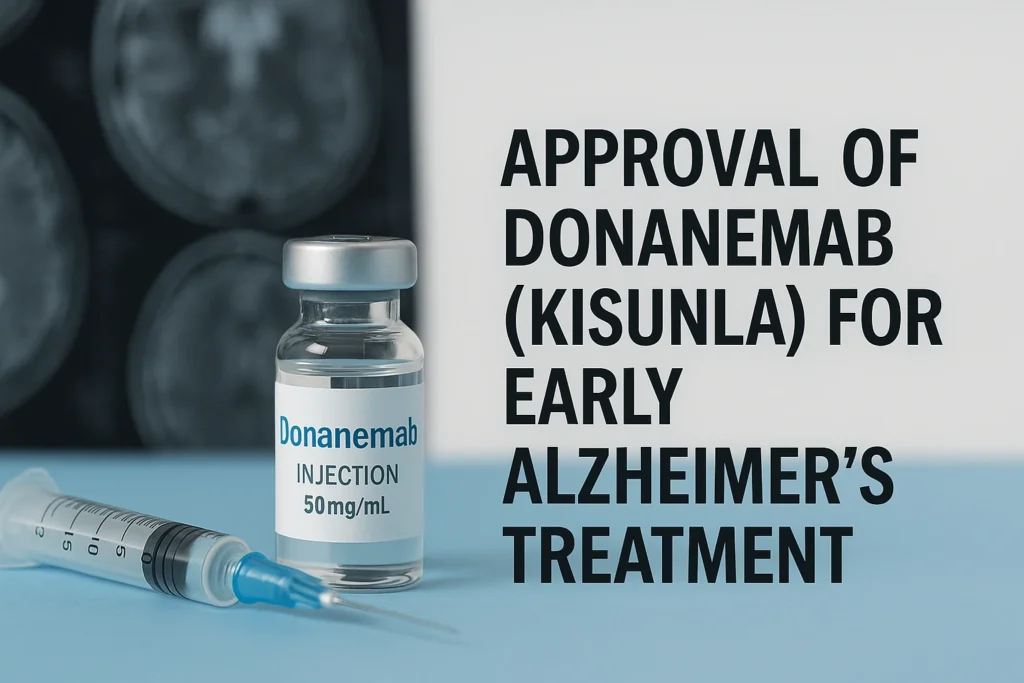Margaret Whitmore’s hands trembled as she unfolded the letter from her neurologist. The 68-year-old former librarian had spent two years watching her mind unravel – first misplacing books at work, then forgetting her granddaughter’s birthday, and most recently getting lost driving home from the grocery store she’d frequented for decades. The official diagnosis of early Alzheimer’s had crushed her. But this letter contained something she never expected to see: “You may qualify for a new treatment that could slow your cognitive decline.”
That treatment – donanemab, now approved in Australia under the brand name Kisunla – represents the most significant advance in Alzheimer’s therapy since 1995. Yet as Margaret would soon discover through tearful consultations with her doctor and strained family discussions around the kitchen table, this scientific breakthrough comes with complex conditions: genetic restrictions that exclude many patients, serious health risks, and a staggering price tag that could exceed $80,000 out of pocket.
Chapter 1: The Science of Hope – How Donanemab Works
Targeting the Biological Hallmarks of Alzheimer’s
For nearly three decades, the “amyloid hypothesis” dominated Alzheimer’s research, proposing that sticky amyloid beta proteins accumulating in the brain were the disease’s primary drivers. Donanemab is the first treatment to conclusively demonstrate that clearing these plaques can modify the disease course:
✔ Amyloid plaque reduction: PET scans show 84% clearance in treated patients
✔ Cognitive impact: Slows decline by 29-35% over 18 months
✔ Functional preservation: Delays loss of daily living skills by 4-7 months
“We’re not talking about a cure, but for the first time we can significantly alter the trajectory. It’s like turning a steep downhill slope into a gentler grade.”
— Professor Colin Masters, Florey Institute of Neuroscience and Mental Health
The Treatment Protocol – What Patients Actually Experience
The reality of treatment involves a demanding medical regimen:
- Monthly IV infusions: 1-2 hour clinic visits every 4 weeks
- Intensive monitoring: Required MRIs every 2-3 months to check for brain swelling
- Duration: Treatment continues until amyloid plaques clear (typically 12-18 months)
- Discontinuation: Therapy stops if dangerous side effects emerge or plaques are cleared
Chapter 2: The Eligibility Maze – Who Actually Qualifies?
Stringent Medical Criteria Create Barriers
Only an estimated 10-20% of Australia’s 400,000 dementia patients may access Kisunla due to strict requirements:
| Requirement | Rationale | Practical Challenge |
|---|---|---|
| Early-stage only | Works best before significant neuron loss | Most diagnoses come too late |
| Confirmed amyloid plaques | Requires PET scan | $1,200 test not covered by Medicare |
| ApoE ε4 gene testing | Identifies high-risk patients | Excludes those most likely to benefit |
| No history of microbleeds | Safety precaution | Rules out many elderly patients |
The Genetic Paradox
The situation creates a cruel irony:
- ApoE ε4 carriers (higher genetic Alzheimer’s risk) show best response…
- …But face 3x greater odds of dangerous side effects (ARIA brain swelling)
- Current guidelines exclude those with two ε4 alleles – precisely the patients who might benefit most
Chapter 3: The Burden of Treatment – Costs and Risks
The Staggering Financial Toll
Treatment expenses create what experts call “the $80,000 question”:
- Drug costs: $56,000 estimated for full 18-month course
- Diagnostic tests:
- PET scans ($4,500 each, typically needed 2-3 times)
- MRIs ($800 monthly for safety monitoring)
- Medical appointments: Neurologist visits ($300/session)
“We risk creating a two-tier system where only the wealthy can buy time with their memories.”
— Maree McCabe AM, CEO of Dementia Australia
The Physical Toll – Significant Side Effects
Common adverse effects include:
- ARIA (Amyloid-Related Imaging Abnormalities):
- Brain swelling occurs in 24% of patients
- Often asymptomatic but can cause headaches, confusion
- Microbleeds: 6% require hospitalization
- Infusion reactions: Fever, chills, nausea in 20% of cases
Chapter 4: Real Stories from the Frontlines
A Patient’s Diary: “The Longest 18 Months”
Excerpts from the journal of Robert Chen, whose wife received donanemab:
“Week 12: Mei recognized our daughter’s voice on the phone today. First time in months. We cried together.”
“Week 42: The MRI showed new microbleeds. The neurologist says we should stop treatment. Mei doesn’t understand why.”
“Month 16: We’re remortgaging our home to pay for the last PET scan. What price can you put on remembering your grandchild’s face?”
Doctor’s Perspective: The Ethical Dilemmas
Dr. Sarah Lim, neurologist at Royal Melbourne Hospital, shares her experience:
“Every week I have to tell patients they’re ineligible. The worst cases are the early-onset patients in their 50s – biologically perfect candidates but excluded because they carry two ApoE ε4 genes. Their devastation is palpable.”
Chapter 5: The Road Ahead – Access and Alternatives
Pathway to PBS Subsidy
The treatment’s future hinges on several developments:
- PBAC Review (Late 2025): Will assess cost-effectiveness
- Diagnostic Improvements: Blood tests may replace expensive PET scans
- Next-Gen Therapies: Oral versions and combination treatments in trials
Global Context – How Australia Compares
| Country | Status | Key Differences |
|---|---|---|
| USA | Medicare covers with restrictions | Requires registry enrollment |
| UK | Rejected by NICE | Deemed not cost-effective |
| Japan | Fast-tracked 2024 approval | Broader eligibility criteria |
Epilogue: A Bittersweet Victory
For Margaret Whitmore, donanemab brought 11 precious months of stability – time she used to record video messages for future family milestones and revisit favorite books while she could still appreciate them. But when we spoke last month, she reflected:
“This drug gave me back mornings where I wake up knowing what day it is. But Alzheimer’s isn’t done with me. Every clear moment now comes with the knowledge of what’s still being taken.”
Her words capture the complex reality of this medical advance – a treatment that offers neither cure nor comfort, but rather the paradoxical gift of watching one’s own decline in slow motion.
Should extremely expensive treatments be rationed based on prognosis? Share your perspective below. 💊🧠




pfx032